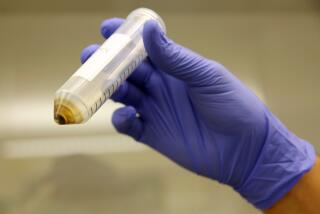Message is mixed on fracking

WASHINGTON -- One year ago, the Environmental Protection Agency finished testing drinking water in Dimock, Pa., after years of complaints by residents who suspected that nearby natural gas production had fouled their wells. The EPA said that for nearly all the 64 homes whose wells it sampled, the water was safe to drink.
Yet as the regulator moved to close its investigation, the staff at the mid-Atlantic EPA office in Philadelphia, which had been sampling the Dimock water, argued for continuing the assessment.
In an internal EPA PowerPoint presentation obtained by the Tribune/Los Angeles Times Washington Bureau, staff members warned their superiors that several wells had been contaminated with methane and substances such as manganese and arsenic, most likely because of local natural gas production.
The presentation, based on data collected over 4 1/2 years at 11 wells around Dimock, concluded that “methane and other gases released during drilling (including air from the drilling) apparently cause significant damage to the water quality.” The presentation also concluded that “methane is at significantly higher concentrations in the aquifers after gas drilling and perhaps as a result of fracking [hydraulic fracturing] and other gas well work.”
Critics say the decision in July 2012 by EPA headquarters in Washington to curtail its investigation at Dimock over the objection of its on-site staff fits a troubling pattern at a time when the Obama administration has used the sharp increase in natural gas production to rebut claims that it is opposed to fossil fuels.
In March 2012, the EPA closed an investigation of methane in drinking water in Parker County, Texas, although the geologist hired by the regulator confirmed that the methane was from gas production. In late June, the EPA dropped a study of possible contamination of drinking water in Pavillion, Wyo., despite its earlier findings of carcinogens, hydrocarbons and other contaminants in the water.
“We don’t know what’s going on, but certainly the fact that there’s been such a distinct withdrawal from three high-profile cases raises questions about whether the EPA is caving to pressure from industry or antagonistic members of Congress,” said Kate Sinding of the Natural Resources Defense Council, an environmental group.
The EPA confirmed the authenticity of the presentation about the Dimock wells but said it was the work of one employee.
“This presentation represents one [on-scene coordinator’s] thoughts regarding 12 samples and was not shared with the public because it was a preliminary evaluation that requires additional assessment in order to ascertain its quality and validity,” said EPA spokeswoman Alisha Johnson.
“The sampling and an evaluation of the particular circumstances at each home did not indicate levels of contaminants that would give EPA reason to take further action,” Johnson said. “Throughout EPA’s work in Dimock, the agency used the best available scientific data to provide clarity to Dimock residents and address their concerns about the safety of their drinking water.”
At the same time, the energy industry and its congressional allies have hammered the EPA for undertaking the studies, which they say are a pretext for regulatory overreach.
“They have attempted to link fracking to water contamination in at least three cases, only to be forced to retract their statements after further scrutiny proved them to be unfounded,” Rep. Lamar Smith (R-Texas), chairman of the House Science Committee, said at a recent hearing.
Robert B. Jackson, professor of environmental sciences at Duke University, who has researched methane contamination in the Dimock area and recently reviewed the presentation, said he was disappointed by the EPA’s decision.
“What’s surprising is to see this data set and then to see EPA walk away from Dimock,” Jackson said. “The issue here is, why wasn’t EPA interested in following up on this to understand it better?”
The EPA staff presentation about Dimock was an interim analysis of water sampling data collected by Pennsylvania regulators and, later, by the EPA, from 2008 to June 2012.
The presentation provides charts for nine of the 11 Dimock-area wells, tracking natural gas production work in the area and the concentration of methane and metals over a four- to five-year period, depending on the well. Some wells underwent a “short-term disruption,” or a rise in methane in the water six to eight months after nearby gas development activity. Over two or three years, the concentration of methane fell.
Four other wells experienced long-term disruption to their water quality, according to the presentation. In those instances, methane levels did not fall over time but remained high after an initial increase or began to climb after a period of decline. The presence of metals such as manganese and arsenic also rose over time in some of those wells.
A study by Jackson and other Duke scientists published in June indicates that drinking water wells near natural gas production in northeastern Pennsylvania, including Dimock, are at greater risk of methane contamination than those farther away.
Methane is the primary component in natural gas. In enclosed spaces, such as sheds and basements, it poses the risk of asphyxiation and explosion. There is little research into the long-term effects on human health from prolonged exposure to methane in drinking water.
Scientists and regulators say that when methane ends up in well water, it is usually because of faulty metal casings inside a natural gas well that allow methane to seep out as it travels to the surface or shoddy concrete work that is supposed to keep gas and water from moving into the space between the well casings and the rock.
Though EPA officials concluded that Dimock water was safe to drink, the mid-Atlantic EPA office nevertheless asked the Centers for Disease Control and Prevention to evaluate the health risk.
Cabot Oil & Gas Corp., the company drilling in Dimock, asserts that the methane in the water is unrelated to oil and gas development. “Through our investigation, Cabot concluded that methane gas existed in groundwater and water wells in the Dimock and Springville townships long before Cabot began drilling in the area,” said Dan O. Dinges, Cabot’s chief executive, in a May 29 letter to the Senate Energy and Natural Resources Committee.
Although methane gas occurs naturally in the area’s aquifers, the Duke study showed that the chemical “fingerprint” of methane in shallow water wells near the gas sites was the same as the natural gas extracted from deep underground.
The EPA PowerPoint presentation identified five wells contaminated with methane whose chemical fingerprint, or isotopic composition, was the same as methane from the Marcellus shale formation at the center of Pennsylvania’s natural gas boom.
Fred Baldassare, a former official at the Pennsylvania Department of Environmental Protection who worked on the state’s Dimock studies, disputed the presentation’s assertion that some wells contained Marcellus methane. Now a consultant for industry and homeowners, Baldassare said there was not enough information about the composition of the methane in the wells to draw conclusions about the origin. “It’s dangerous and inappropriate to interpret this data in a vacuum,” he said.
Jackson disagreed, arguing that the methane found does not naturally occur in drinking water. “The burden of proof is different here,” he said. “The question we’re asking is, ‘Was there enough evidence to warrant further study?’ The EPA scientist clearly thought so.”
Twitter: @neelaeast
More to Read
Start your day right
Sign up for Essential California for news, features and recommendations from the L.A. Times and beyond in your inbox six days a week.
You may occasionally receive promotional content from the Los Angeles Times.







